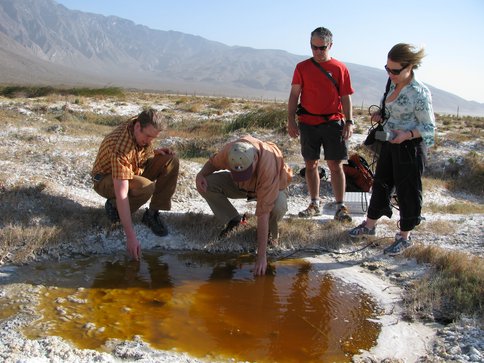2009 Annual Science Report
 Arizona State University
Reporting | JUL 2008 – AUG 2009
Arizona State University
Reporting | JUL 2008 – AUG 2009
Stoichiometry of Life, Task 2b: Field Studies - Cuatro Cienegas
Project Summary
Cuatro Cienegas is a unique biological preserve in which there is striking microbial diversity, potentially related to extreme scarcity of phosphorus. We aim to understand this relationship.
Project Progress
In February 2009, Co-I Elser led a preliminary scouting trip to Cuatro Cienegas, Mexico, field sites involving several project investigators and collaborators (Anbar, Shock, Neuer, Hartnett) and a project graduate student (Jess Corman), along with NAI postdoc Eric Boyd (MSU) and others (ASU faculty Nancy Grimm and Dan Childers). The group had intensive discussions with our collaborators at UNAM (Souza, Eguiarte) and Rice University (Siefert), inspected field sites at Pozas Rojas, and took preliminary samples in various localities. The group also visited a local high school and gave a presentation about Astrobiology.
To prepare for future investigations, Jessica Corman (PhD student, ASU) and Drew Bryck (undergraduate, ASU) collected physicochemical data on the Pozas Rojas in Cuatro Ciénegas, Mexico during an extended visit in July-August 2009. Sediment and water samples were collected from 5 potential salterns; these samples are being processed for the extended Redfield ratio, DNA sequences, and gene expression. They also collected hydrologic information about the salterns, including evaporation rates during the summer and isotopic hydrogen and oxygen values. This trip provided the important insight that more than half of the salterns were dried up by August. Thus, experimentation in future years will need to begin in springtime. They also performed several manipulative experiments to address stoichiometric relationships in elemental cycling of carbon, nitrogen, phosphorus, and calcium using the stromatolite-oncoid ecosystem found in the Río Mezquites. Biomass samples from the oncoids are currently being processed at ASU for elemental composition and DNA and RNA expression. Finally, Corman is working with Adam Monroe (PhD student, ASU) to develop a method to sequentially extra phosphorus from the oncoids to quantify the various organic, mineral, and recalcitrant forms. The experiments in Río Mezquites were highlighted in two local Mexican newspapers.
Figure 1. Sampling at Cuatro Cienegas. Montana State University NAI Postdoc Eric Boyd and ASU Team co-Is Everett Shock, James Elser and Susanne Neuer collect samples from a saltern at the Cuatro Cienegas (Mexico) field site. (Photo credit: A. D. Anbar)
-
PROJECT INVESTIGATORS:
-
PROJECT MEMBERS:
Ariel Anbar
Co-Investigator
Susanne Neuer
Co-Investigator
Everett Shock
Co-Investigator
Daniel Childers
Collaborator
Nancy Grimm
Collaborator
Hilairy Hartnett
Collaborator
Valeria Souza
Collaborator
Eric Boyd
Postdoc
Jessica Corman
Graduate Student
Adam Monroe
Graduate Student
Drew Bryck
Undergraduate Student
-
RELATED OBJECTIVES:
Objective 5.1
Environment-dependent, molecular evolution in microorganisms
Objective 5.2
Co-evolution of microbial communities
Objective 5.3
Biochemical adaptation to extreme environments
Objective 6.1
Effects of environmental changes on microbial ecosystems
Objective 6.2
Adaptation and evolution of life beyond Earth

